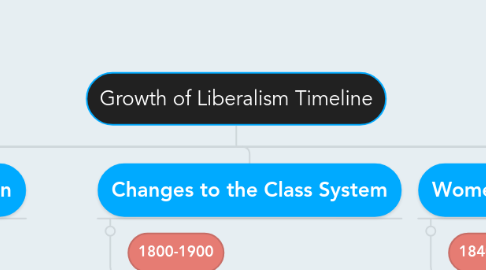
1. Renaissance
1.1. 1300-1600
1.1.1. -Renaissance: Rebirth -Time in Europe that filled the gap between middle ages and modern time -Emphasized worth of the individual -Europeans changed their way of thinking regarding individualism -Many new inventions were created such as the printing press
2. Reformation
2.1. 1500-1650
2.1.1. -European churches got restructured -Less commitment to the church -More individualism allowed -Bible was translated into many different languages through the printing press -Control of church was declining -Individualism became predominant in many societies but didn't surpass collectivism
3. Enlightenment
3.1. 1700-1800
3.1.1. -Renaissance and Reformation led to the belief in the importance of the individual -When this idea became more popular, European philosophers promoted the ideas that led to classical liberalism -Ultimately promoted the ideas of classical liberalism -A new, wealthy middle-class emerged and there were many struggles due to the acceptance of radical ideas
4. American Revolution
4.1. 1775-1783
4.1.1. -Ideas of the Enlightenment led to the ideas of the American Revolution -Every colony of Great Britain had its own name and government -Settlers in America were taxed by Britain and forced to pay high tariffs on imports -American Colonies got frustrated by high prices and the monopoly that was forced upon them, so they wanted independence from Great Britain -Americans created a government which was controlled by its citizens -America broke away from Great Britain, but also started a war -This led to the Declaration of Independence for their new country
5. French Revolution
5.1. 1789-1799
5.1.1. -Liberalism evolved into an ideology -People fought for rights and freedom -Government went bankrupt through the tax burden paid by ordinary people -Outdated and ineffective taxation system made matters worse -French government was in massive debt because of the wars they involved themselves in -Third Estate began to revolt -Leaders believed in liberalism, but depended on support of regular people -Became a Reign of Terror where thousands of people lost their lives and property
6. Industrial Revolution
6.1. 1750-1850
6.1.1. -Resulted in changes of social, economic, and political aspects -Several factors contributed to new technology, more private property, and better individual rights and freedoms -More efficient technology was used to farm land and make more food, clothes, etc. -As more machines were invented, there were fewer jobs available for citizens -People demanded greater political rights -Nations competed for power and wealth
7. Changes to the Class System
7.1. 1800-1900
7.1.1. -Society changed ideas on classical liberalism -Social classes got diminished, while class structure based on wealth emerged -Classical liberalism valued individualism and the economy improved -Economic freedom was valued and right to own private property was demanded -Had greater chances to become more wealthy and join higher/wealthier classes
8. Women Suffrage
8.1. 1840-1920
8.1.1. -Based around the term 'feminism' -Classical liberalism provided women rights, but very few classical liberal thinkers were willing to concede any rights to women -Many suffragists argued for women's rights -Canada gave women voting rights about 100 years ago -Some nations still haven't given women the right to vote
9. Henry Ford Movement
9.1. 1910
9.1.1. -Gave equality and proper wages to workers -Treated workers with respect and dignity -Provided weekends off -Consumers were more pleased with hearing workers were treated better -Overall, changed the way factory owners dealt with the working class
10. The Great Depression
10.1. 1929-1939
10.1.1. -Longest economic downturn in history -Started from stock market crash in 1929 -Long lasting influence on liberal democratic governments which led to more government involvement in economies -Consumer spending and investing dropped greatly -Unemployment rate in North America was 25% -Many people had extreme amounts of debt -Banks shut down and became bankrupt -Resulted in more North Americans questioning the classic liberal economic system and governments role
11. New Deal
11.1. 1933-1934
11.1.1. -Franklin D. Roosevelt represented this idea -Implemented public works programs to put people to work -Echoed "square deal" -Represented the beginning of shift to the welfare state and a mixed economy -By 1950's-60's, the welfare state was a reality in most democratic countries such as Canada -Roosevelt was the first to convert to Keyne's theory -Theory stated that government should spend more and reduce taxes during recession -Also stated that government should spend less money in good times and raise taxes
12. Square deal
12.1. 1935-1936
12.1.1. -Roosevelt wanted capital and labour to be treated equally and fairly -Based on three basic ideas: conservation of natural resources, control of corporations, and consumer protection -Protected both business and labor -The Progressive Era gave similar laws -Food industry was monitored during this era as well -Went on to found a new political party - The National Progressive Party -Platform contained the new kind of liberalism, often called progressivism
13. Modern Liberalism
13.1. 1850-1950
13.1.1. -Change in liberalism where much freedom given to society -Every race, religion, and ethnicity is better-tolerated and welcome in society - Democracy is "Most Fair" way of governing a country and its people -Went against the "Dictatorship" way of government and promoted Democracy, where people choose and control government

